Arabic to English Translation*
With celebrations and ceremonies, on May 14, 2024, the new building for the “Afrin Local Council” was inaugurated by Mustafa Masatli, the Governor of Hatay, Turkey, who serves as the primary authority in the region. He also chaired the first council meeting immediately following the inauguration. Abdul rahman Mustafa, the “President of the Syrian Interim Government,” was notably absent and felt compelled to visit the new council building on June 2, 2024. A ribbon-cutting ceremony was staged for him at the main entrance for photo opportunities. The government’s Facebook page posted about the “new building’s inauguration” by him, while the council’s page avoided publishing the ribbon-cutting photo and referred to his presence that day as a “visit by the Prime Minister.”
This underscores once again that Turkish authorities are the ultimate decision-makers in Afrin, confirming that Turkey is an actual occupying country. The Syrian National Coalition – the Muslim Brotherhood, its interim government, and the Syrian militias loyal to Ankara – are merely tools of the Justice and Development Party (AKP) government and its leader, Recep Tayyip Erdoğan.
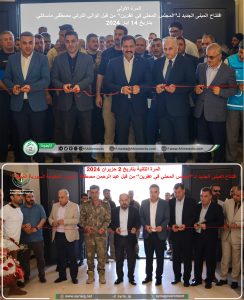
The following are facts about the prevailing situation:
= Detention and Torture of a Kurdish Civilian:
Two weeks ago, a group from the “Military Police in Raju” militia raided the home of the civilian “Ali Saleh Saleh, /45/ years old,” from the village of “Alttania,” in central Raju. He was humiliated in front of his family, beaten, and insulted before being taken to their platoon, where he was tortured for several hours before being released. This occurred after he refused to hand over his home to “Colonel Abu Mudhar“, the head of the platoon. The house had previously been vacated by another settler whose family had occupied it rent-free since 2018, claiming it belonged to his absent brother, although all neighbors and acquaintances in the town affirm that the house belongs to “Ali”.
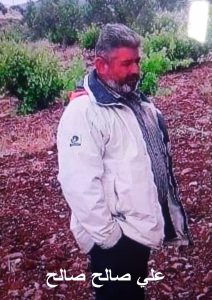
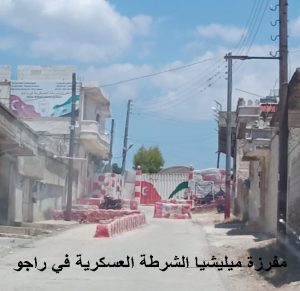
= Arbitrary Arrests:
The Occupation Authorities Arrested:
-During the last two weeks, consecutively, the civilians “Aref Manan Rashid, /70/ years old, Omar Gouleen Rashid, /60/ years old, Shaban Hussein Hamo, /60/ years old, Faiq Ismail Ismail, /56/ years old, Ismail Suleiman Bilal, /42/ years old, Salah Ali Seen/Hashko family, /49/ years old, Sheikh Muhammad Muhammad, /70/ years old, Izzat Bilal Ismail, /56/ years old, Khalil Rashid Sheikho, /50/ years old, Muhammad Mustafa Ameen/Naisek family, /50/ years old, Muhammad Sheikho Qanbar, /66/ years old.
These individuals, from the villages of Meydano – Raju, were detained by Turkish intelligence and the militia police on charges of links to the previous self-administration (commune, night watch…..). They were released after being held for two to three days, each fined $200, with an additional $100 to be paid at their next court session. The charges were documented against them along with their personal information, regardless of their innocence.
= Drying of Irrigation Canals – Maydanki Dam:
The Maydanki Dam (April 17 Dam) is a strategic project in the region with a maximum storage capacity of around /220/ million cubic meters of water. Currently, it supplies drinking water to the cities of Azaz and Afrin, providing approximately 25 million cubic meters annually (has increased since the pre-crisis years due to the doubling of the resident populations in these cities). Additionally, the dam supports the irrigation of approximately /30,000/ hectares of agricultural fields and lands (including olive trees, fruit trees, wheat, barley, vegetables, etc.). However, in recent years, the dam’s irrigation capacity has diminished. The Afrin River dried up last summer, and this year, irrigation water has not yet been released into the irrigation network channels, except for minimal amounts flowing in the river. As a result, grain seasons have ended, and most vegetable and fruit orchards are in their critical growing stages. This is due to the reduced amount of water retained in the dam during the winter, coupled with the shutdown of irrigation stations (such as Gamrouk, Tall Tawil/Asteir, Juimkeh, and Bableet) due to the theft of their equipment by militias.
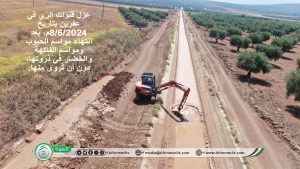
According to a local source, theTurkish coordinator overseeing the dam has not been retaining winter rainwater as effectively as before the Turkish occupation in 2018. Previously, all rainwater was stored, and any excess was allowed to flow into the river. However, this winter, the river’s water level was kept high to flow into the Turkish Reyhanli Dam at the Afrin River’s mouth and fill it (with a storage capacity of /900/ million cubic meters), which was inaugurated in 2020. Additionally, there are four dams on the Afrin River’s tributaries in Turkey, the largest being the Upper Afrin Dam with a storage capacity of 38 million cubic meters, inaugurated in 2021.
Due to the drying of most surface water wells, many farmers have resorted to drilling deep artesian wells, over /350/ meters deep, incurring additional irrigation costs.
A comparison of two images of the Maydanki Dam, one from January 10, 2019, showing water overflowing the dam, and another from June 4, 2024, showing low water levels, highlights the significant difference in water storage between the two years. This disparity exists despite similar rainfall levels in both years, exceeding /500/ mm.
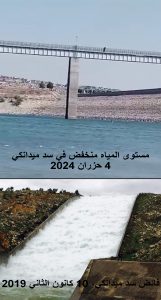
= Forest Fires:
With the onset of each summer since the Turkish occupation in 2018, forest fires in Afrin have increased significantly compared to the periods under state institutions and during the local and self-administration years between /2012 – 2018/. This increase is due to a systematic policy of destruction against natural forests, which covered (18,500 hectares) and artificial forests, which covered (21,000 hectares) in Afrin before the occupation. Currently, the degradation rate exceeds 60%, meaning approximately (/6/ million natural forest trees + 13 million planted trees = /19/ million trees) have been destroyed, in addition to millions of smaller trees. This destruction has been carried out through extensive cutting, uprooting with heavy machinery, and setting fires. For example:
– On the evening of Monday, June 3, 2024, a fire was set in the forest near “Chamo” village – Sharra /Sharran, burning /40/ pine trees and /20/++ olive trees over an area of approximately 40 dunams, according to the “Syrian Civil Defense,” which stated that their teams worked for more than three hours to extinguish the fire.
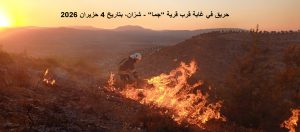
– On Tuesday, June 4, 2024, a fire was set in a valley between the villages of “Nazeh” and “Darwisho” – Sharra /Sharran, consuming natural forest trees and dozens of olive trees belonging to the nearby village of “Beilleh”.
– On Wednesday, June 5, 2024, a fire was set on a mountain opposite “Cheiqlma” village – Raju, burning a large area of natural forest trees. A local source confirmed that the goal was to remove the remnants and thin branches to expose the tree trunks that had been cut, facilitating their extraction.
– On the evening of Friday, June 7, 2024, a fire was set in the forest near “Ramadano” village – Jenderes, burning approximately /150/ dunams of green space, according to the “Syrian Civil Defense,” which stated that their teams worked for /14/ hours to extinguish the fire.
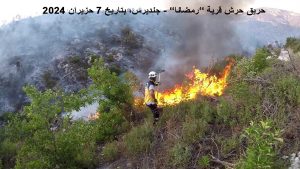
– Beginning on the evening of Monday, June 3, 2024, fires were set in the forest on Mount Hawar, located between the Raju and Bulbul districts. By Tuesday morning, the fires had spread, and thick smoke columns filled the sky. The fires continued until the early hours of Thursday, June 6, 2024. The “Syrian Civil Defense” announced the end of the firefighting operations after /44/ hours of continuous work, stating that the fires consumed approximately /150/ hectares of green space and about /1,200/ olive and grape trees belonging to the residents of the villages of “Dikeih and Cheih” overlooking the forest, according to a local source.
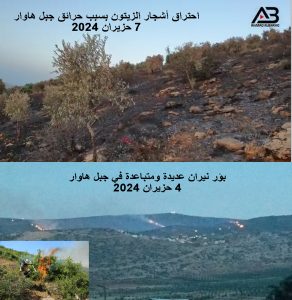
Mount Hawar holds a strategic geographic and natural positions, featuring caves and the ruins of an ancient castle. It hosts a pristine natural forest of common oak, wild olive, arbutus, zorood, and broad-leaved forest companions, with a genetic reservoir of seeds. It should have been a natural reserve and a refuge for wild animals.
The village of “Chiyeh/al-Jabaliyah” is located at the top of the mountain, which rises /960/ meters above sea level. Its residents were completely displaced by the Turkish army, which established a military base there during its control of the area in March 2018. For political and military-security reasons, Turkish-backed militias are driven to cut down and burn the forest on a large scale.
Evidence supporting the theory that the forest fires in Afrin are deliberate includes:
– Multiple points and separate locations of fires within the same forest, such as those on Mount Hawar.
– Efforts to cover up previous cutting operations, or to clear roads and remove logging remnants to expose and uproot buried trunks.
– The lack of participation by militias and local authorities in firefighting efforts.
– Turkey’s failure to participate in or provide assistance for firefighting efforts, despite having significant capabilities, including land and air equipment and specialized firefighting tools. The fire sites are less than /30/ kilometers far from Turkey’s borders. Before 2011, Turkey participated in firefighting operations in Syria.
– Leaving the firefighting responsibility to the “Syrian Civil Defense,” which has limited capabilities and is not reinforced.
= Deadly Clashes Among Civilians in Afrin City:
Following a dispute over the seizure of a plot of land belonging to a resident of Afrin city, which had been seized since 2018 during the region’s occupation, near the Mazout Highway and the new building of the local council west of the city, where there are commercial barracks, violent clashes broke out on the evening of Monday, June 3, 2024. The clashes, involving light and heavy weapons, were between two armed groups, mainly from Deir Ezzor countryside. One group is led by “Mustafa al-Kahm” and belongs to the “Ahrar al-Sharqiya” militia, while the other group is led by “Abu Malik al-Deiri,” who split from Ahrar al-Sharqiya and joined the “Hamzat Division” militia. The fighters took to the rooftops and clashed in the city’s streets, resulting in the burning of a barrack store along with parts of a house, damage to dozens of homes and cars from bullets and shells, significant material losses, trapping of some hospitals, the killing of four fighters from both sides, and the wounding of over /20/ people, including civilians. This caused panic, shop closures, and residents remaining in their homes.
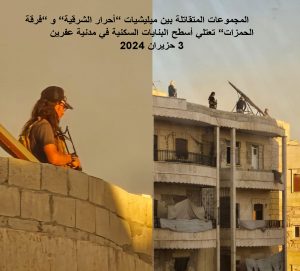
The clashes extended to the Jenderes district, where forces from the “Sultan Suleiman Shah Division – Amshat,” allied with the Hamzat Division under the name “Joint Forces,” attacked the headquarters of the “Liberation and Construction Movement,” which includes the main allies “Ahrar al-Sharqiya” and “Jaysh al-Sharqiya,” taking control of some in Jenderes and the Hamam border crossing with Turkey. Other Amshat groups claimed to have taken over a checkpoint at the “Amoro” village junction and the villages of “Hayat, Siwa/al-Yetimah, and Keel Eabo” in the Mobato/Ma’batli district, expelling Ahrar al-Sharqiya. In the Raju district, Hamzat forces bombed some Ahrar al-Sharqiya positions. “Ahrar al-Sharqiya” evacuated their headquarters in the city, leaving behind one or more headquarters of the “Liberation and Construction Movement,” which had looted thousands of homes, shops, and warehouses in Afrin city and seized them, along with dozens of real estate records and agricultural lands since 2018.
It won’t be long after these bloody clashes in Afrin and the devastating forest fires that President Erdogan, his administration, and their Syrian followers will shamelessly speak of a safe zone in northern Syria and claim that Afrin enjoys security and stability!
08.06.2024
Media Office-Afrin
Kurdish Democratic Unity Party in Syria (Yekiti)
——————
Images:
– The inauguration of the new building of the “Local Council in Afrin,” first by Mustafa Masatli, the Governor of Hatay, Turkey, and then by Abdul Rahman Mustafa, the “President of the Syrian Interim Government.”
– The civilian who was assaulted, “Ali Saleh Saleh.”
– The Raju platoon of the Military Police militia, led by “Lieutenant Colonel Abu Mudhar.”
– The Meydanki Dam between 2019 and 2024.
– The isolation of irrigation channels in Afrin on June 8, 2024, after the end of the grain and fruit and vegetable seasons at their peak, without being irrigated.
– A forest fire near Chamo village – Sharran, on June 4, 2026.
– A forest fire in Ramadano village – Jenderes, on June 7, 2024.
– The forest fires on Mount Hawar, June 6, 2024.
– Armed fighters from the clashing groups of the “Ahrar al-Sharqiya” and “Hamzat Division” militias occupying the rooftops of residential buildings in Afrin city, June 3, 2024.
—————-
* Under the supervision of the European Organization of the Kurdish Democratic Unity Party in Syria (Yekîtî).
————
You can download the full file by clicking here: